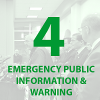Emergency Public Information and Warning

Capability 4: Emergency Public Information and Warning
Definition: Emergency public information and warning is the ability to develop, coordinate, and disseminate information, alerts, warnings, and notifications to the public and incident management responders.
Functions and Associated Performance Measures: This capability consists of the ability to perform the functions listed below. Associated CDC-defined performance measures are also listed below.
Function 1: Activate the emergency public information system
Function 2: Determine the need for a joint public information system
Function 3: Establish and participate in information system operations
Function 4: Establish avenues for public interaction and information exchange
Function 5: Issue public information, alerts, warnings, and notifications
Measure 1: Time to issue a risk communication message for dissemination to the public
Emergency Public Information and Warning: Online Trainings
 Don't Panic: Principles of Crisis and Risk Communication Scenario
Don't Panic: Principles of Crisis and Risk Communication Scenario
This interative scenario, developed by UMPERLC, provides training in the principles of crisis and risk communication during a response for public health emergency. This scenario is intended for health practitioners who need to increase their ability to effectively communicate with the public, media, health care providers and response community during a public health emergency. Estimated time to complete is one hour.
National Incident Management System (IS-701.a)
This FEMA course introduces Multiagency Coordination (MAC) Systems as described in the National Incident Management System (NIMS), and shows how these systems can be used to improve incident response. After taking this course, you should be able to improve the overall coordination with, and support for, incident management by developing and operating within Multiagency Coordination Systems. Estimated time for completion is two hours.
S-29: Public Information Officer Awareness
The goal of this awareness course is to provide an orientation to the public information function and the role of the Public Information Officer (PIO) in the public safety/emergency management environment. Topics addressed include: understanding the PIO role, using tools and resources, communicating effectively, preparing the community, and communicating in an incident.
This course, developed by the Harvard School of Public Health H-PERLC, addresses the principles of public communication. The goal of the course is to improve one’s ability on how to communicate risk, recognize people’s reactions to risk information, understand the role of social contextual factors in generating and receiving risk information, and recognizing challenges associated with communicating risk in the 21st century. Estimated time for competion is two hours.
The Crisis and Emergency Risk Communication training program from the CDC introduces the fundamentals of CDC's Crisis & Emergency Risk Communication (CERC). The course has been designed to serve those who will perform crisis and risk communication and media relations in the event of a public health emergency. The target audiences include federal, state, and local public health professionals; healthcare professionals; emergency medical services professionals; preparedness partners; and civic and community leaders. Estimated time for completion is three hours.
Being able to communicate effectively is a necessary and vital part of the job for every emergency manager, planner, and responder. This FEMA course is designed to improve your communication skills. It addresses: Basic communication skills, How to communicate in an emergency, How to identify community-specific communication issues, Using technology as a communication tool, Effective oral communication, and How to prepare an oral presentation.
Emergency Public Information and Warning: Resources
Emergency Dark Site: A Toolkit on How to Build, Use, and Maintain a Dark Site for Public Health Emergencies
This toolkit, from the Santa Clara County Advanced Practice Center, is intended to serve local health departments in setting up a public health department emergency dark site -- a static Web page used to post critical public health emergency messages when a server goes down.
Get Ready for Call Center Surge: A Toolkit for Local Health Departments
Develop or enhance existing resources and partnerships to increase call center capacity and improve the effectiveness of phone-based emergency communications with the public. This Advanced Practice Center toolkit was developed by with a focus on rural and suburban settings.
Risk Communication in Rural Settings
Developed by Ware County Board of Health (An Advanced Practice Center mini-site), Risk Communicating Resources for Rural Areas is a toolkit to help rural public health departments communicate their message to the community during an emergency or disaster. The goal of this toolkit is to put comprehensive, accessible, and ready-to-use materials in the hands of local health departments. The tool contains information on the following topics: Communicating during a natural event, Communicating during a biological event, Communicating during a chemical event, Communicating during a radiological event, Communicating during a mass vaccination/medical event, How to have a Joint Information Center in your community, and Non-traditional ways to communicate. Now includes: Social Media Templates.
Staff Allocation Decision Guide
This tool, from NACCHO Advanced Practice Center, Multnomah County Health Department, guides an experienced Local Health Department (LHD) administrator or Incident Commander (IC) through decision-making processes to allocate staff between two major types of public health operations both in advance of, and during, a public health emergency. The tool applies to any incident calling for both disease investigation and prophylaxis operations.
Emergency Public Information and Warning: Drills & Exercises
Community Connectors Program
The Community Connectors program is a model for how emergency response planners can develop relationships and open lines of communication with diverse members of their community prior to an emergency. Multnomah County Health Department (in Oregon) used an internal resource to conduct this program: staff who had already established relationships with an underserved community and were willing to strengthen the relationship between the community and the health department. The main role of Community Connectors is to support public information and risk communication measures under the director of the Public Information Officer (PIO). Materials include an exercise script and player guide.